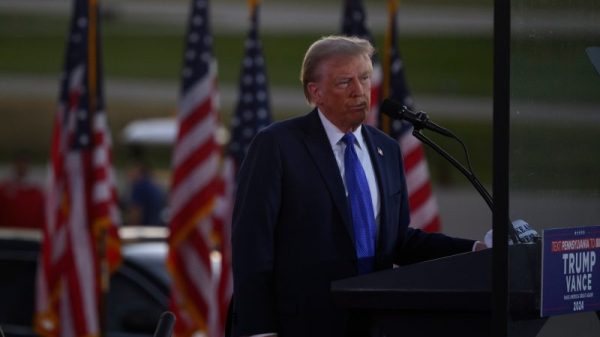With the economy humming along and the stock market, despite some recent twists and turns, hanging in there pretty well, it’s a tough case to sell that higher interest rates are having a substantially negative impact on the economy.
So what if policymakers just decide to keep rates where they are for even longer, and go through all of 2024 without cutting?
It’s a question that, despite the current conditions, makes Wall Street shudder and Main Street queasy as well.
“When rates start climbing higher, there has to be an adjustment,” said Quincy Krosby, chief global strategist at LPL Financial. “The calculus has changed. So the question is, are we going to have issues if rates remain higher for longer?”
The higher-for-longer stance was not what investors were expecting at the beginning of 2024, but it’s what they have to deal with now as inflation has proven stickier than expected, hovering around 3% compared with the Federal Reserve’s 2% target.
Recent statements by Fed Chair Jerome Powell and other policymakers have cemented the notion that rate cuts aren’t coming in the next several months. In fact, there even has been talk about the potential for an additional hike or two ahead if inflation doesn’t ease further.
That leaves big questions over when exactly monetary policy easing will come, and what the central bank’s position to remain on hold will do to both financial markets and the broader economy.
Krosby said some of those answers will come soon as the current earnings season heats up. Corporate officers will provide key details beyond sales and profits, including the impact that interest rates are having on profit margins and consumer behavior.
“If there’s any sense that companies have to start cutting back costs and that leads to labor market trouble, this is the path of a potential problem with rates this high,” Krosby said.
But financial markets, despite a recent 5.5% sell-off for the S&P 500, have largely held up amid the higher-rate landscape. The broad market, large-cap index is still up 6.3% year to date in the face of a Fed on hold, and 23% above the late October 2023 low.
History tells differing stories about the consequences of a hawkish Fed, both for markets and the economy.
Higher rates are generally a good thing so long as they’re associated with growth. The last period when that wasn’t true was when then-Fed Chair Paul Volcker strangled inflation with aggressive hikes that ultimately and purposely tipped the economy into recession.
There is little precedent for the Fed to cut rates in robust growth periods such as the present, with gross domestic product expected to accelerate at a 2.4% annualized pace in the first quarter of 2024, which would mark the seventh consecutive quarter of growth better than 2%. Preliminary first-quarter GDP numbers are due to be reported Thursday.
For the past several decades, higher rates have not been linked to recessions.
On the contrary, Fed chairs have often been faulted for keeping rates too low for too long, leading to the dot-com bubble and subprime market implosions that triggered two of the three recessions this century. In the other one, the Fed’s benchmark funds rate was at just 1% when the Covid-induced downturn occurred.
In fact, there are arguments that too much is made of Fed policy and its broader impact on the $27.4 trillion U.S. economy.
“I don’t think that active monetary policy really moves the economy nearly as much as the Federal Reserve thinks it does,” said David Kelly, chief global strategist at J.P. Morgan Asset Management.
Kelly points out that the Fed, in the 11-year run between the financial crisis and the Covid pandemic, tried to bring inflation up to 2% using monetary policy and mostly failed. Over the past year, the pullback in the inflation rate has coincided with tighter monetary policy, but Kelly doubts the Fed had much to do with it.
Other economists have made a similar case, namely that the main issue that monetary policy influences — demand — has remained robust, while the supply issue that largely operates outside the reach of interest rates has been the principle driver behind decelerating inflation.
Where rates do matter, Kelly said, is in financial markets, which in turn can affect economic conditions.
“Rates too high or too low distort financial markets. That ultimately undermines the productive capacity of the economy in the long run and can lead to bubbles, which destabilizes the economy,” he said.
“It’s not that I think they’ve set rates at the wrong level for the economy,” he added. “I do think the rates are too high for financial markets, and they ought to try to get back to normal levels — not low levels, normal levels — and keep them there.”
As a matter of policy, Kelly said that would translate into three quarter-percentage point rate cuts this year and next, taking the fed funds rate down to a range of 3.75%-4%. That’s about in line with the 3.9% rate at the end of 2025 that Federal Open Market Committee members penciled in last month as part of their “dot-plot” projections.
Futures market pricing implies a fed funds rate of 4.32% by December 2025, indicating a higher rate trajectory.
While Kelly is advocating for “a gradual normalization of policy,” he does think the economy and markets can withstand a permanently higher level of rates.
In fact, he expects the Fed’s current projection of a “neutral” rate at 2.6% is unrealistic, an idea that is gaining traction on Wall Street. Goldman Sachs, for instance, recently has opined that the neutral rate — neither stimulative nor restrictive — could be as high as 3.5%. Cleveland Fed President Loretta Mester also recently said it’s possible that the long-run neutral rate is higher.
That leaves expectations for Fed policy tilting toward cutting rates somewhat but not going back to the near-zero rates that prevailed in the years after the financial crisis.
In fact, over the long run, the fed funds rate going back to 1954 has averaged 4.6%, even given the extended seven-year run of near-zero rates after the 2008 crisis until 2015.
One thing that has changed dramatically, though, over the decades has been the state of public finances.
The $34.6 trillion national debt has exploded since Covid hit in March 2020, rising by nearly 50%. The federal government is on track to run a $2 trillion budget deficit in fiscal 2024, with net interest payments thanks to those higher interest rates on pace to surpass $800 billion.
The deficit as a share of GDP in 2023 was 6.2%; by comparison, the European Union allows its members only 3%.
The fiscal largesse has juiced the economy enough to make the Fed’s higher rates less noticeable, a condition that could change in the days ahead if benchmark rates hold high, said Troy Ludtka, senior U.S. economist at SMBC Nikko Securities America.
“One of the reasons why we haven’t noticed this monetary tightening is simply a reflection of the fact that the U.S. government is running its most irresponsible fiscal policy in a generation,” Ludtka said. “We’re running massive deficits into a full-employment economy, and that’s really keeping things afloat.”
However, the higher rates have begun to take their toll on consumers, even if sales remain solid.
Credit card delinquency rates climbed to 3.1% at the end of 2023, the highest level in 12 years, according to Fed data. Ludtka said the higher rates are likely to result in a “retrenchment” for consumers and ultimately a “cliff effect” where the Fed ultimately will have to concede and lower rates.
“So, I don’t think they should be cutting anytime in the immediate future. But at some point that’s going to have to happen, because these interest rates are simply crushing particularly low-income-earning Americans,” he said. “That is a big portion of the population.”






































